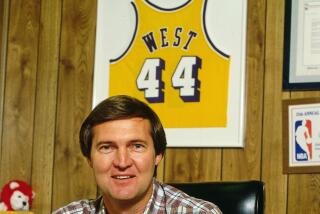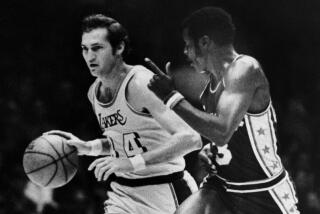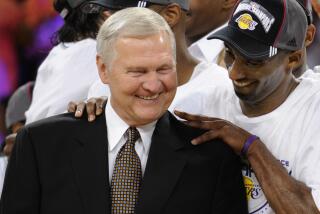STAR WARTS
- Share via
WASHINGTON — What if they had an NBA season and a Clipper game broke out?
This league doesn’t have to check the calendar to know the ‘90s are over. It’s no longer gaining TV ratings while everyone else loses them, nor are its stars still deemed the most popular and fan-friendliest. Now it’s only another big league, beset by problems, real and perceptual.
The sky might not be falling, but it’s cloudy enough that there will be meetings on all levels during the All-Star weekend to address the pertinent questions: How do we revive interest, speed up the game and encourage our players to get along with their wives, girlfriends, teammates, fans and the law?
Not that this makes the NBA different, but that’s the point. As recently as three seasons ago, it was.
A post-Michael Jordan retrenchment was inevitable, but it has lasted longer than they hoped, taken them lower than they expected to go and has yet to bottom out. Commissioner David Stern now does so much spin control, his staff has to come in periodically and unwind him.
So much for being hot, hot, hot. In the halcyon ‘90s when their finals twice got higher ratings than the World Series, Stern’s name was linked to vacant commissionerships in the NFL and baseball (to say nothing of the U.S. Senate), prompting NBA owners to bump him up to $8 million a year. The NHL reportedly sounded out his deputy, Russ Granik, who demurred, before hiring Gary Bettman, the NBA’s counsel.
“We were on such an incredible roll, there was admiration to the point of reverence,” an NBA team official says. “Every sport and every league said, ‘We’ve got to have a David Stern.’ He was in a position to name his ticket . . . and he did.
“But it’s hard to keep topping yourself. In hindsight, we were riding Michael Jordan’s coattails while we were telling ourselves, ‘Boy are we good.’ ”
Boy, were they due for a fall.
Now amid this reality check, they have to take refuge in context, as in: Yes, but things are tough all over.
“The reality,” Stern says, “is the strongest sport of all, the NFL on ‘Monday Night Football,’ had extraordinary publicity this year because of Dennis Miller--and it was down 9% from its historic low. And that’s the best sports programming there is. That’s the reality of that, so there’s no one who’s not going to deal with declining ratings. . . .
“We recognize, we would like to have higher ratings and 100% sellouts and everything a commissioner wishes for, but, all things considered, we like where we are.”
All things considered, he’d at least like to see his ratings level off. In the league office, they say this is a perception problem, which is true, because their problems aren’t unique, but it’s not the whole story.
The NBA’s perception problem is threefold: 1) bad news; 2) bad perception and, worst of all, 3) too few people doing the perceiving.
TV ratings, which took a 20% hit last season in what they thought was the nadir of their post-Jordan era, are down an additional 15%.
Attendance is off only 1%, but that represents tickets distributed, not sold or used. Actual paid attendance in some forlorn places, such as Atlanta’s brand-new Philips Arena, is significantly less.
Or as Celtic broadcaster Howard David said at one game, when it looked as if there was half of the 11,194 that the Hawks announced:
“I had more people at my bar mitzvah.”
Passing the Torch . . . Oops!
“I have to admit there are times where it hurts personally. It causes me to reflect on what one wants to do with the rest of one’s life. I’ve given a lot of years to the industry. It’s been good to me. . . . But it’s become more and more difficult.”
--Phoenix Sun owner Jerry Colangelo after Penny Hardaway’s arrest
Once, this league was a bridge into the future.
Stern was smart enough to understand the benefit of promoting his players, rather than warring with them, and lucky enough to have a long line of gracious stars: Julius Erving, who handed the torch to Magic Johnson (as Magic always put it) and Larry Bird, before they handed it to Jordan . . .
Jordan transcended everything but, unfortunately, that included their future.
When he left, no one, not veterans such as Karl Malone or established stars such as Shaquille O’Neal and Grant Hill or kids such as Kobe Bryant, Vince Carter and Allen Iverson could measure up.
Indeed, the worst thing that could happen, as with Bryant and Carter (and Hardaway, Hill and Jerry Stackhouse) was to be compared to Jordan, because then you had to win titles every year or crash and burn.
Stature can only be earned over time. It has been only two years and two titles since Jordan left. The bland Tim Duncan led the San Antonio Spurs to the first one. Shaq and Kobe led the Lakers to the second, then retreated to their separate corners, which wasn’t what Stern was hoping for, either.
In the third season Post-Mike, the hottest selling sneaker is Jordan’s re-released $125 Retro XI with its black patent leather border that he wore in his 1995 comeback.
NBA players are still highly recognizable, but this works both ways, as Stern notes ruefully.
“We’re a staple of everyday American life,” he says. “And frankly, that’s one of the issues. When you invite the kind of intense coverage that we get, that we covet, each one of your warts is going to be covered with the same intensity.”
Not to mention their frequent fits of pique and brushes with the law . . . the arrests of three of the Suns’ four full-time starters in separate incidents . . . the Denver Nuggets boycotting a practice . . . the Seattle SuperSonics unseating popular coach Paul Westphal . . . the generational conflict between the old guys, as represented by Malone and Charles Oakley, and the hip-hop generation, as represented by the hard-core, controversy-prone Iverson.
So a lot of embarrassing stuff happened, intercut with condemnations from someone such as Oakley (“This league is garbage”) until the chorus demanding somebody do something was so loud, union head Billy Hunter said he’d meet with Stern this weekend to discuss image problems.
Not that anyone should expect much from that meeting. A wire service mistakenly quoted Hunter as saying “the basketball-watching public” isn’t ready for players like Iverson “with their tattoos and cornrows to be the face of the league.”
Actually, Hunter’s view is just the opposite, contesting the league’s right to restrict style.
This isn’t a problem that looks susceptible to a quick fix . . . or any fix. This isn’t a college dorm in the ‘50s. Stern can’t enforce a curfew and a dress code, much as he’d like to.
Then there’s the arena problem, as in, they put up almost all new ones and they’re still hurting.
In the ‘90s, Stern took his league into an unprecedented building boom. However, they missed the lesson that baseball learned, that smaller was better. With one proud exception, Indiana’s retro-style Conseco Fieldhouse, the new NBA buildings weren’t as intimate as the ones they replaced, such as Chicago Stadium or Boston Garden, but vast structures to hold more luxury suites, such as the United Center or Staples Center.
NBA teams are still charging new-building prices--in a particularly bad bit of timing, it became the first league to hit a $50 average ticket this season--and the novelty has worn off or the electricity isn’t there.
In an ominous bit of feedback, the Web site, https://NBATalk.com, asked visitors: “Can you personally afford to attend an NBA game?”
The answers:
“I can go occasionally: 44.1%.
“I can go once a season at most: 33.3%.
“No way, I can’t afford it: 16.5%.
“Yes, I have season tickets: 6.03%.”
In other words, almost 50% of a pool of hard-core NBA fans say they can only afford to see a game once a year or not at all.
Oh Yeah, the Game
Not that Stern is getting much in the way of congratulations lately, but he actually has the league in excellent shape, structurally.
The contracts with NBC and Turner, which went up 170% to $2.6 billion two seasons ago, expire after next season, by which time you’d better believe Stern will be hoping to show network execs signs of a turnaround.
In any case, he’ll make out, because the major leagues’ rights fees have become so precious to the networks, with Fox and all the cable competition they face.
And, unlike past bonanzas, NBA players will get a defined, rather than a disproportionate share of this pie, thanks to the bargaining agreement, which caps salaries.
The NBA still has $120 million-plus contracts (O’Neal, Kevin Garnett) but for the first time in a long time, its players aren’t the best-paid, not after the Texas Rangers gave Alex Rodriguez a $252-million deal, obliging the New York Yankees to discuss a $190-million contract with Derek Jeter.
But finance is one thing, basketball another.
All through the ‘90s, scoring declined alarmingly. Not that anyone minded because the ratings kept climbing.
Now that the ratings are going the other way, Stern is finally signaling he’s willing to throw out the zone-defense rules in an attempt to open up the game.
“I think that there has been a valid point raised,” he says, “and that is the defense has gotten so far ahead of the offense and has led to a certain offensive style that somehow seeks to exploit the illegal defensive guidelines, that we should open up everything for debate.
“Maybe because of my loyalty to the game, which I continue to profess, I’ve been very slow to make changes. Maybe I’ve been doing it a disservice.”
Someone has been doing it a disservice. But the problem is that no one knows what will persuade coaches to speed things up, if anything.
The league tried moving the three-point line in and scoring dropped.
It moved it back and scoring dropped again.
It tried taking the contact out of defense and scoring went up for a season . . . and then dropped precipitously this season.
Nevertheless, Stern is taking all this in stride, he says.
“Someone said to me, ‘Is this a very difficult time?’ ” he said.
“I said, ‘You haven’t seen difficulty until you’ve been here in the late ‘70s when revenues were at $100 million for all of our teams, combined. When people were talking about the league being too black. When the first revelations about drugs had to do with our players. When everybody said that a $250,000 average salary was preposterous, we could never survive it.’ ”
Survival is no longer an issue, but, these days, progress is.
(BEGIN TEXT OF INFOBOX / INFOGRAPHIC)
Second-Rate
A look at decline in viewership of the NBA:
NBC REGULAR SEASON
Season Rating/Share
2000-01*: 3.0/7
1999-2000: 3.3/7
1998-99**: 4.3/7
1997-98: 4.6/12
1996-97: 4.7/12
1995-96: 5.0/13
*
TNT, TBS REGULAR SEASON
2000-01*: 1.1/2
1999-00: 1.3/2
1998-99**: 1.7/3
1997-98: 1.7/3
1996-97: 1/.7/3
*
NBC FINALS
2000: 11.6/21
1999: 11.3/21
1998: 18.7/33
1997: 16.8/30
1996: 16.7/31
1995: 13.9/25
*--Season to date.
**--Lockout season.
NBA All-Star Game
ROSTERS
Eastern Conference
*--*
Player Pos. Ht. Wt. Ray Allen, Milwaukee G 6-5 205 x-Vince Carter, Toronto F 6-6 225 z-Antonio Davis, Toronto F-C 6-9 230 xy-Grant Hill, Orlando F 6-8 225 Allan Houston, New York G 6-6 200 x-Allen Iverson, Philadelphia G 6-0 165 Stephon Marbury, New Jersey G 6-2 180 Anthony Mason, Miami F 6-8 260 x-Tracy McGrady, Orlando G 6-8 210 xy-Alonzo Mourning, Miami C 6-10 261 z-Dikembe Mutombo, Atlanta C 7-2 265 y-Theo Ratliff, Philadelphia C 6-10 225 Glenn Robinson, Milwaukee F 6-7 230 z-Latrell Sprewell, New York F 6-5 190 Jerry Stackhouse, Detroit G 6-6 218
*--*
Coach: Larry Brown, Philadelphia
*
Western Conference
*--*
Player Pos. Ht. Wt. x-Kobe Bryant, Lakers G 6-7 210 x-Tim Duncan, San Antonio F 7-0 260 z-Vlade Divac, Sacramento C 7-1 260 Michael Finley, Dallas G 6-7 215 Kevin Garnett, Minnesota F 6-11 220 x-Jason Kidd, Phoenix G 6-4 212 Karl Malone, Utah F 6-9 259 Antonio McDyess, Denver F 6-9 245 xy-Shaquille O’Neal, Lakers C 7-1 315 Gary Payton, Seattle G 6-4 180 David Robinson, San Antonio C 7-1 250 Rasheed Wallace, Portland F 6-11 225 x-Chris Webber, Sacramento F 6-10 245
*--*
Coach: Rick Adelman, Sacramento
Note: x-starter; y-injured, will not play; z-injury replacement)
RESULTS
*--*
Year Score MVP 1951 East 111, West 94 Ed Macauley, Boston 1952 East 108, West 91 Paul Arizin, Philadelphia 1953 West 79, East 75 George Mikan, Minneapolis 1954 East 98, West 93, OT Bob Cousy, Boston 1955 East 100, West 91 Bill Sharman, Boston 1956 West 108, East 94 Bob Pettit, St. Louis 1957 East 109, West 97 Bob Cousy, Boston 1958 East 130, West 118 Bob Pettit, St. Louis 1959 West 124, East 108 Elgin Baylor, Minneapolis; Bob Pettit, St. Louis 1960 East 125, West 115 Wilt Chamberlain, Philadelphia 1961 West 153, East 131 Oscar Robertson, Cincinnati 1962 West 150, East 130 Bob Pettit, St. Louis 1963 East 115, West 108 Bill Russell, Boston 1964 East 111, West 107 Oscar Robertson, Cincinnati 1965 East 124, West 123 Jerry Lucas, Cincinnati 1966 East 137, West 94 Adrian Smith, Cincinnati 1967 West 135, East 120 Rick Barry, San Francisco 1968 East 144, West 124 Hal Greer, Philadelphia 1969 East 123, West 112 Oscar Robertson, Cincinnati 1970 East 142, West 135 Willis Reed, New York 1971 West 108, East 107 Lenny Wilkens, Seattle 1972 West 112, East 110 Jerry West, Lakers 1973 East 104, West 84 Dave Cowens, Boston 1974 West 134, East 123 Bob Lanier, Detroit 1975 East 108, West 102 Walt Frazier, New York 1976 East 123, West 109 Dave Bing, Detroit 1977 West 125, East 124 Julius Erving, Philadelphia 1978 East 133, West 125 Randy Smith, Buffalo 1979 West 134, East 129 David Thompson, Denver 1980 East 144, West 136, OT George Gervin, San Antonio 1981 East 123, West 120 Tiny Archibald, Boston 1982 East 120, West 118 Larry Bird, Boston 1983 East 132, West 123 Julius Erving, Philadelphia 1984 East 154, West 145, OT Isiah Thomas, Detroit 1985 West 140, East 129 Ralph Sampson, Houston 1986 East 139, West 132 Isiah Thomas, Detroit 1987 West 154, East 149, OT Tom Chambers, Seattle 1988 East 138, West 133 Michael Jordan, Chicago 1989 West 143, East 134 Karl Malone, Utah 1990 East 130, West 113 Magic Johnson, Lakers 1991 East 116, West 114 Charles Barkley, Philadelphia 1992 West 153, East 113 Magic Johnson, Lakers 1993 West 135, East 132, OT Karl Malone and John Stockton, Utah 1994 East 127, West 118 Scottie Pippen, Chicago 1995 West 139, East 112 Mitch Richmond, Sacramento 1996 East 129, West 118 Michael Jordan, Chicago 1997 East 132, West 120 Glen Rice, Charlotte 1998 East 135, West 114 Michael Jordan, Chicago 1999 No game 2000 West 137, East 126 Tim Duncan, San Antonio; Shaquille O’Neal, Lakers
*--*
More to Read
Go beyond the scoreboard
Get the latest on L.A.'s teams in the daily Sports Report newsletter.
You may occasionally receive promotional content from the Los Angeles Times.










